Critical Dialogue and Power Relations
VerifiedAdded on 2021/04/19
|15
|4438
|43
AI Summary
This assignment provides a comprehensive review of the works related to Vygotsky's sociocultural approach, covering topics such as critical dialogue, power relations, democratic dialogic education, and its applications in various fields like early childhood development, education, and psychology. The selected readings include articles from journals like Archives of Design Research, Journal of Pediatrics and Child Health, and International Journal of Environmental and Science Education, among others.
Contribute Materials
Your contribution can guide someone’s learning journey. Share your
documents today.
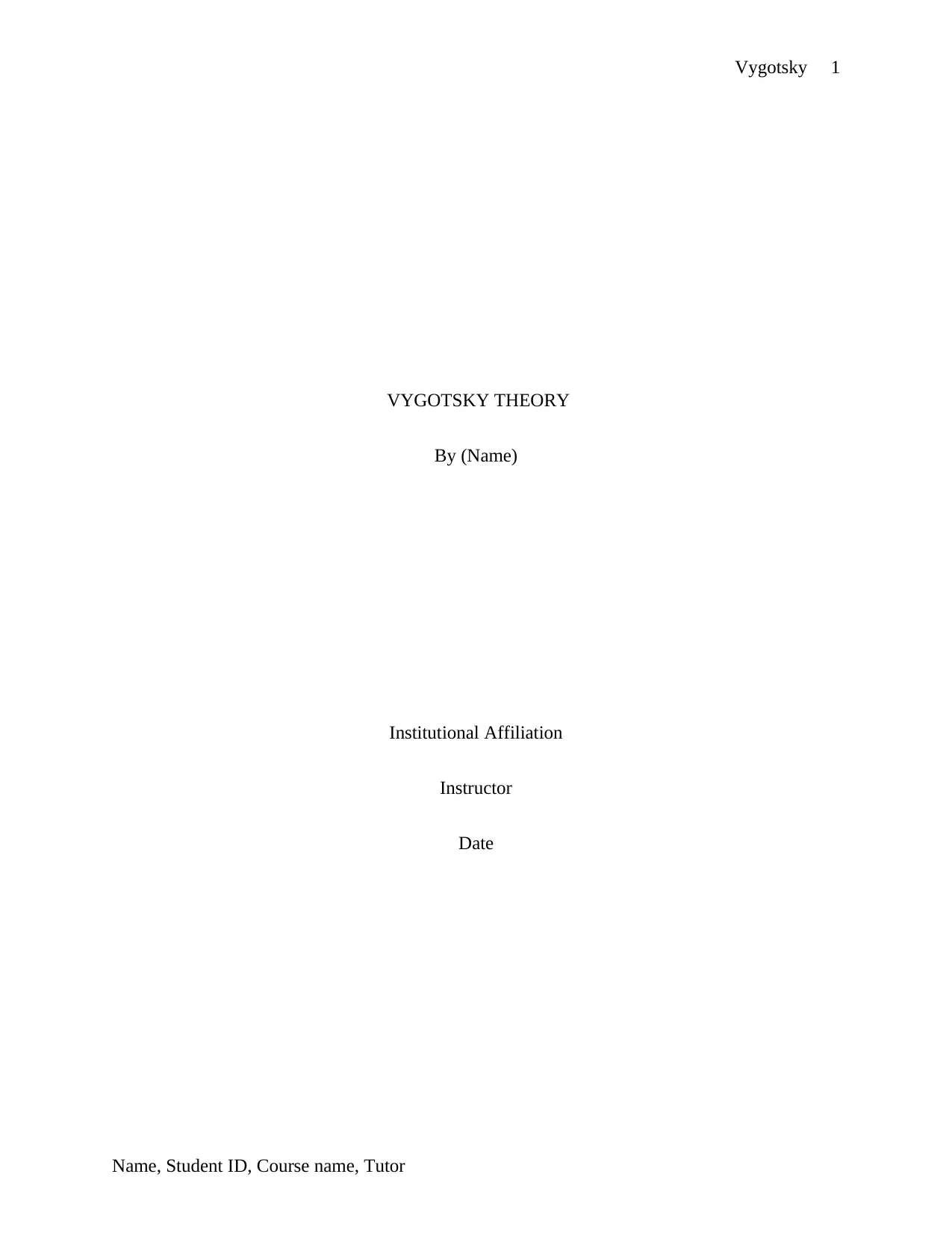
Vygotsky 1
VYGOTSKY THEORY
By (Name)
Institutional Affiliation
Instructor
Date
Name, Student ID, Course name, Tutor
VYGOTSKY THEORY
By (Name)
Institutional Affiliation
Instructor
Date
Name, Student ID, Course name, Tutor
Secure Best Marks with AI Grader
Need help grading? Try our AI Grader for instant feedback on your assignments.
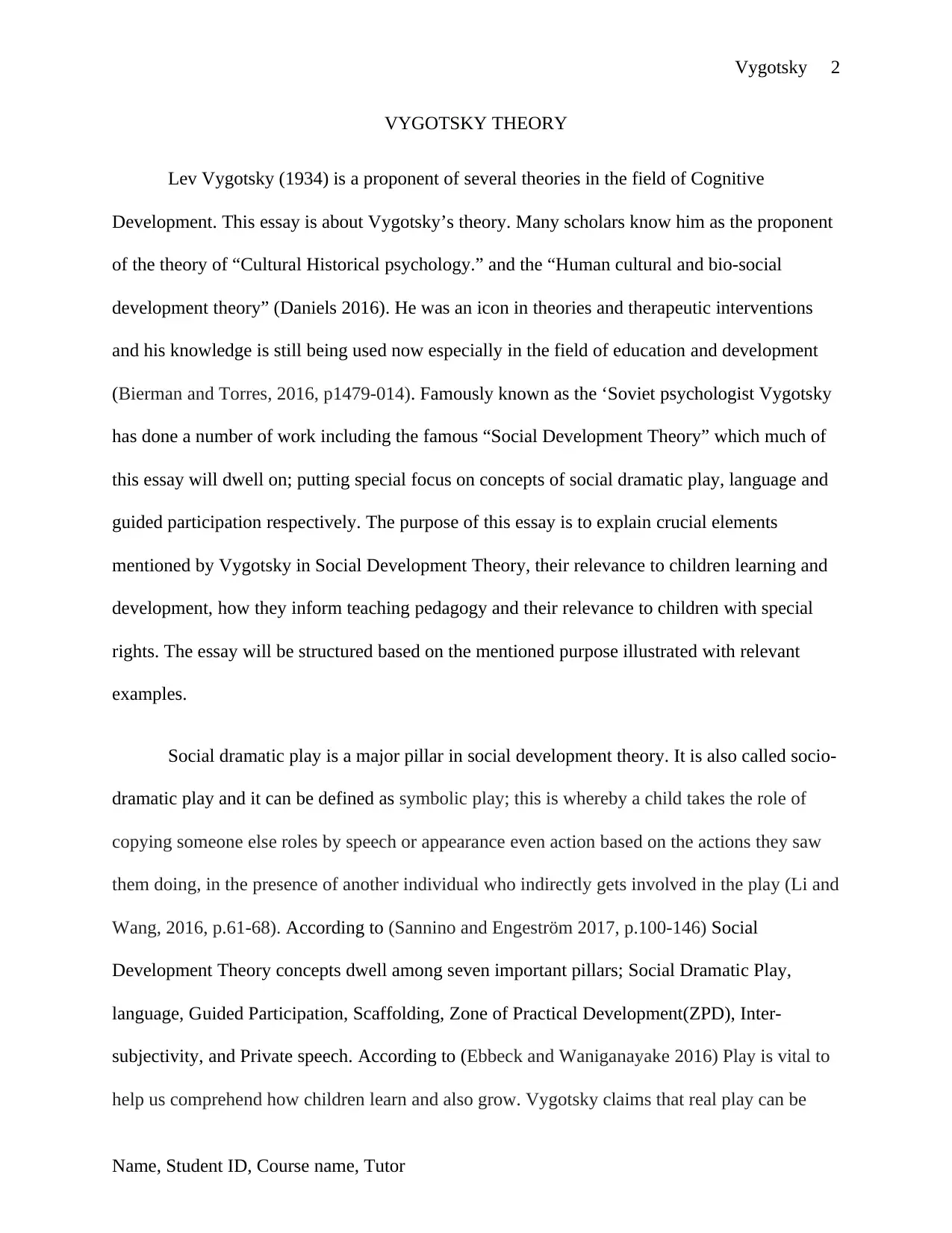
Vygotsky 2
VYGOTSKY THEORY
Lev Vygotsky (1934) is a proponent of several theories in the field of Cognitive
Development. This essay is about Vygotsky’s theory. Many scholars know him as the proponent
of the theory of “Cultural Historical psychology.” and the “Human cultural and bio-social
development theory” (Daniels 2016). He was an icon in theories and therapeutic interventions
and his knowledge is still being used now especially in the field of education and development
(Bierman and Torres, 2016, p1479-014). Famously known as the ‘Soviet psychologist Vygotsky
has done a number of work including the famous “Social Development Theory” which much of
this essay will dwell on; putting special focus on concepts of social dramatic play, language and
guided participation respectively. The purpose of this essay is to explain crucial elements
mentioned by Vygotsky in Social Development Theory, their relevance to children learning and
development, how they inform teaching pedagogy and their relevance to children with special
rights. The essay will be structured based on the mentioned purpose illustrated with relevant
examples.
Social dramatic play is a major pillar in social development theory. It is also called socio-
dramatic play and it can be defined as symbolic play; this is whereby a child takes the role of
copying someone else roles by speech or appearance even action based on the actions they saw
them doing, in the presence of another individual who indirectly gets involved in the play (Li and
Wang, 2016, p.61-68). According to (Sannino and Engeström 2017, p.100-146) Social
Development Theory concepts dwell among seven important pillars; Social Dramatic Play,
language, Guided Participation, Scaffolding, Zone of Practical Development(ZPD), Inter-
subjectivity, and Private speech. According to (Ebbeck and Waniganayake 2016) Play is vital to
help us comprehend how children learn and also grow. Vygotsky claims that real play can be
Name, Student ID, Course name, Tutor
VYGOTSKY THEORY
Lev Vygotsky (1934) is a proponent of several theories in the field of Cognitive
Development. This essay is about Vygotsky’s theory. Many scholars know him as the proponent
of the theory of “Cultural Historical psychology.” and the “Human cultural and bio-social
development theory” (Daniels 2016). He was an icon in theories and therapeutic interventions
and his knowledge is still being used now especially in the field of education and development
(Bierman and Torres, 2016, p1479-014). Famously known as the ‘Soviet psychologist Vygotsky
has done a number of work including the famous “Social Development Theory” which much of
this essay will dwell on; putting special focus on concepts of social dramatic play, language and
guided participation respectively. The purpose of this essay is to explain crucial elements
mentioned by Vygotsky in Social Development Theory, their relevance to children learning and
development, how they inform teaching pedagogy and their relevance to children with special
rights. The essay will be structured based on the mentioned purpose illustrated with relevant
examples.
Social dramatic play is a major pillar in social development theory. It is also called socio-
dramatic play and it can be defined as symbolic play; this is whereby a child takes the role of
copying someone else roles by speech or appearance even action based on the actions they saw
them doing, in the presence of another individual who indirectly gets involved in the play (Li and
Wang, 2016, p.61-68). According to (Sannino and Engeström 2017, p.100-146) Social
Development Theory concepts dwell among seven important pillars; Social Dramatic Play,
language, Guided Participation, Scaffolding, Zone of Practical Development(ZPD), Inter-
subjectivity, and Private speech. According to (Ebbeck and Waniganayake 2016) Play is vital to
help us comprehend how children learn and also grow. Vygotsky claims that real play can be
Name, Student ID, Course name, Tutor
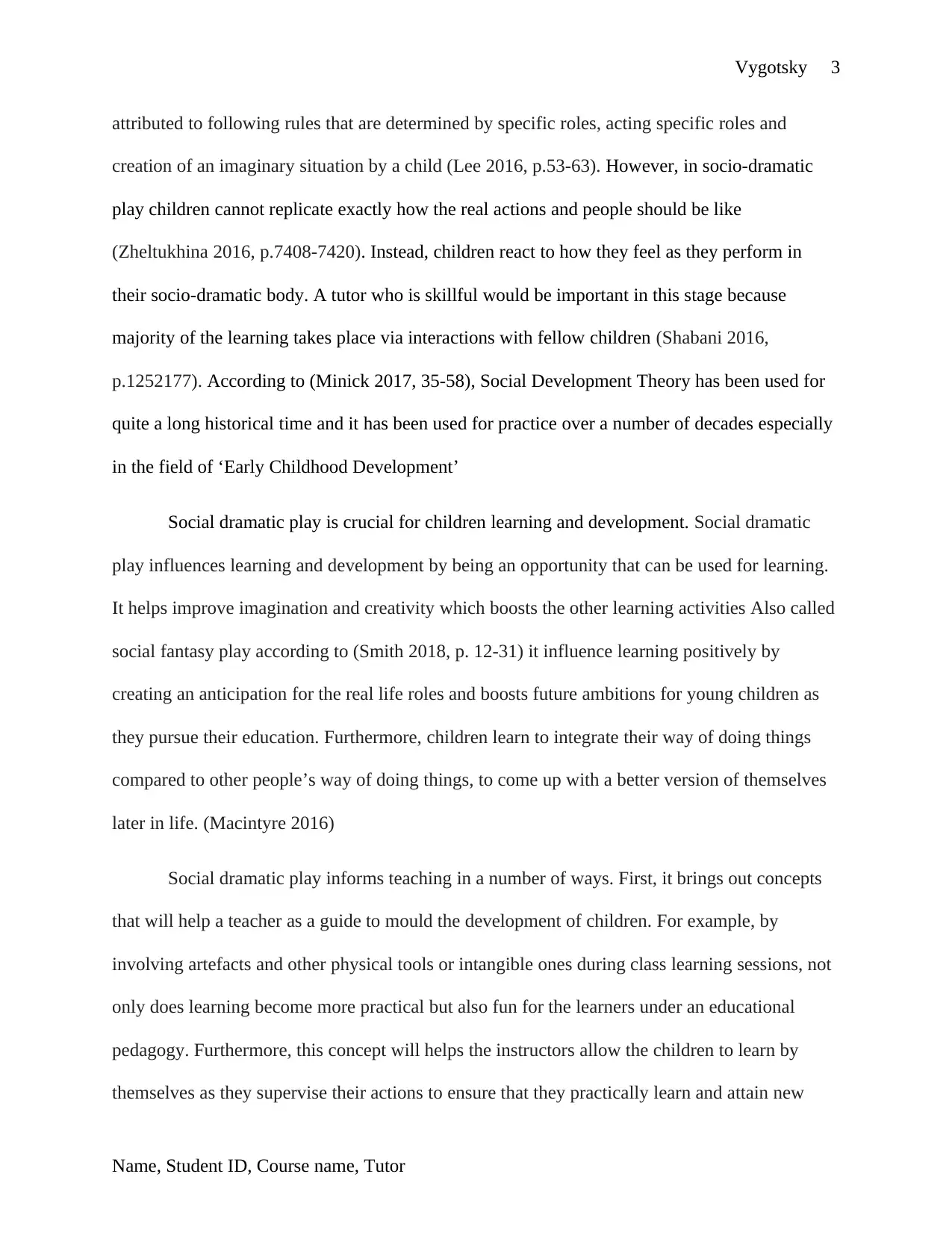
Vygotsky 3
attributed to following rules that are determined by specific roles, acting specific roles and
creation of an imaginary situation by a child (Lee 2016, p.53-63). However, in socio-dramatic
play children cannot replicate exactly how the real actions and people should be like
(Zheltukhina 2016, p.7408-7420). Instead, children react to how they feel as they perform in
their socio-dramatic body. A tutor who is skillful would be important in this stage because
majority of the learning takes place via interactions with fellow children (Shabani 2016,
p.1252177). According to (Minick 2017, 35-58), Social Development Theory has been used for
quite a long historical time and it has been used for practice over a number of decades especially
in the field of ‘Early Childhood Development’
Social dramatic play is crucial for children learning and development. Social dramatic
play influences learning and development by being an opportunity that can be used for learning.
It helps improve imagination and creativity which boosts the other learning activities Also called
social fantasy play according to (Smith 2018, p. 12-31) it influence learning positively by
creating an anticipation for the real life roles and boosts future ambitions for young children as
they pursue their education. Furthermore, children learn to integrate their way of doing things
compared to other people’s way of doing things, to come up with a better version of themselves
later in life. (Macintyre 2016)
Social dramatic play informs teaching in a number of ways. First, it brings out concepts
that will help a teacher as a guide to mould the development of children. For example, by
involving artefacts and other physical tools or intangible ones during class learning sessions, not
only does learning become more practical but also fun for the learners under an educational
pedagogy. Furthermore, this concept will helps the instructors allow the children to learn by
themselves as they supervise their actions to ensure that they practically learn and attain new
Name, Student ID, Course name, Tutor
attributed to following rules that are determined by specific roles, acting specific roles and
creation of an imaginary situation by a child (Lee 2016, p.53-63). However, in socio-dramatic
play children cannot replicate exactly how the real actions and people should be like
(Zheltukhina 2016, p.7408-7420). Instead, children react to how they feel as they perform in
their socio-dramatic body. A tutor who is skillful would be important in this stage because
majority of the learning takes place via interactions with fellow children (Shabani 2016,
p.1252177). According to (Minick 2017, 35-58), Social Development Theory has been used for
quite a long historical time and it has been used for practice over a number of decades especially
in the field of ‘Early Childhood Development’
Social dramatic play is crucial for children learning and development. Social dramatic
play influences learning and development by being an opportunity that can be used for learning.
It helps improve imagination and creativity which boosts the other learning activities Also called
social fantasy play according to (Smith 2018, p. 12-31) it influence learning positively by
creating an anticipation for the real life roles and boosts future ambitions for young children as
they pursue their education. Furthermore, children learn to integrate their way of doing things
compared to other people’s way of doing things, to come up with a better version of themselves
later in life. (Macintyre 2016)
Social dramatic play informs teaching in a number of ways. First, it brings out concepts
that will help a teacher as a guide to mould the development of children. For example, by
involving artefacts and other physical tools or intangible ones during class learning sessions, not
only does learning become more practical but also fun for the learners under an educational
pedagogy. Furthermore, this concept will helps the instructors allow the children to learn by
themselves as they supervise their actions to ensure that they practically learn and attain new
Name, Student ID, Course name, Tutor
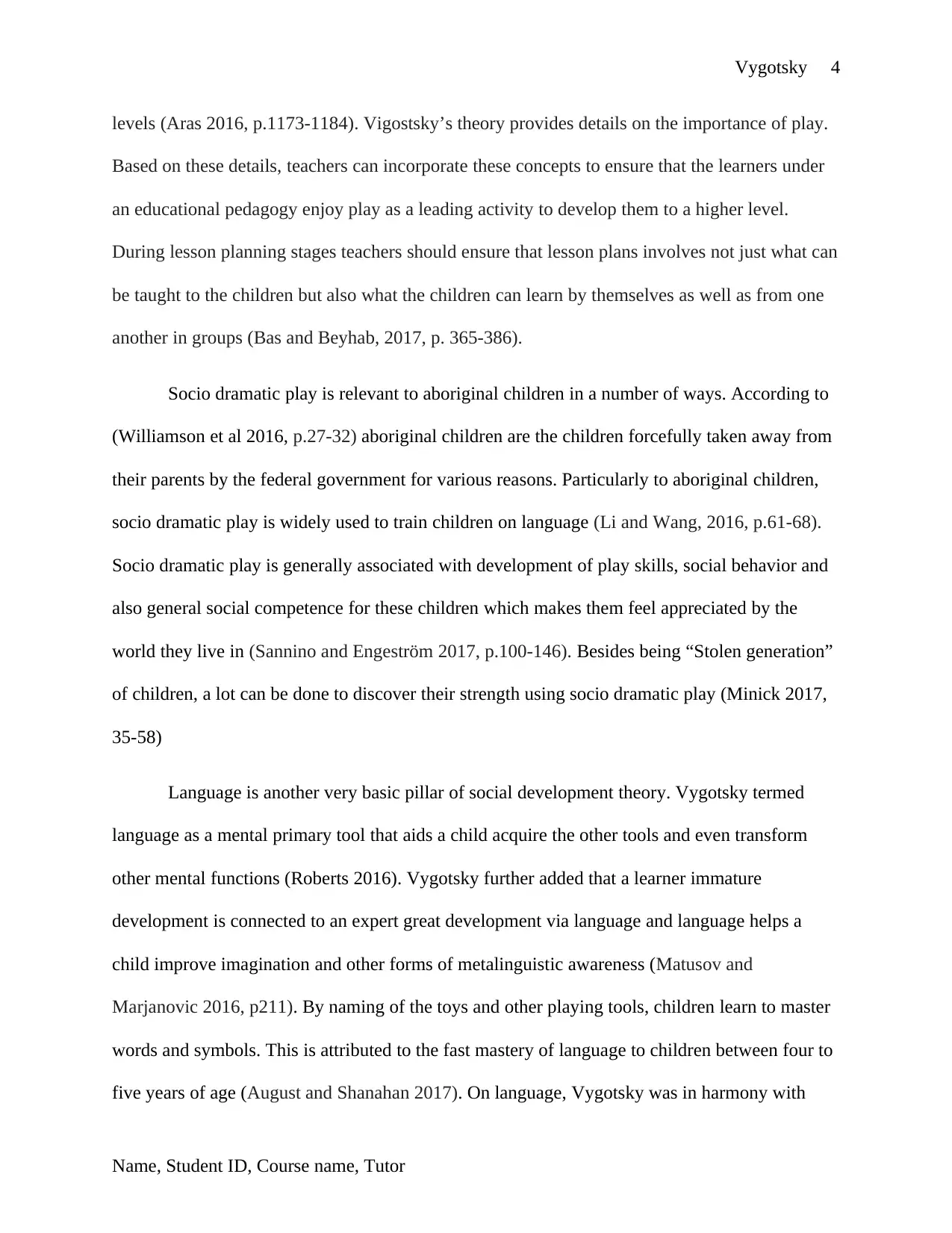
Vygotsky 4
levels (Aras 2016, p.1173-1184). Vigostsky’s theory provides details on the importance of play.
Based on these details, teachers can incorporate these concepts to ensure that the learners under
an educational pedagogy enjoy play as a leading activity to develop them to a higher level.
During lesson planning stages teachers should ensure that lesson plans involves not just what can
be taught to the children but also what the children can learn by themselves as well as from one
another in groups (Bas and Beyhab, 2017, p. 365-386).
Socio dramatic play is relevant to aboriginal children in a number of ways. According to
(Williamson et al 2016, p.27-32) aboriginal children are the children forcefully taken away from
their parents by the federal government for various reasons. Particularly to aboriginal children,
socio dramatic play is widely used to train children on language (Li and Wang, 2016, p.61-68).
Socio dramatic play is generally associated with development of play skills, social behavior and
also general social competence for these children which makes them feel appreciated by the
world they live in (Sannino and Engeström 2017, p.100-146). Besides being “Stolen generation”
of children, a lot can be done to discover their strength using socio dramatic play (Minick 2017,
35-58)
Language is another very basic pillar of social development theory. Vygotsky termed
language as a mental primary tool that aids a child acquire the other tools and even transform
other mental functions (Roberts 2016). Vygotsky further added that a learner immature
development is connected to an expert great development via language and language helps a
child improve imagination and other forms of metalinguistic awareness (Matusov and
Marjanovic 2016, p211). By naming of the toys and other playing tools, children learn to master
words and symbols. This is attributed to the fast mastery of language to children between four to
five years of age (August and Shanahan 2017). On language, Vygotsky was in harmony with
Name, Student ID, Course name, Tutor
levels (Aras 2016, p.1173-1184). Vigostsky’s theory provides details on the importance of play.
Based on these details, teachers can incorporate these concepts to ensure that the learners under
an educational pedagogy enjoy play as a leading activity to develop them to a higher level.
During lesson planning stages teachers should ensure that lesson plans involves not just what can
be taught to the children but also what the children can learn by themselves as well as from one
another in groups (Bas and Beyhab, 2017, p. 365-386).
Socio dramatic play is relevant to aboriginal children in a number of ways. According to
(Williamson et al 2016, p.27-32) aboriginal children are the children forcefully taken away from
their parents by the federal government for various reasons. Particularly to aboriginal children,
socio dramatic play is widely used to train children on language (Li and Wang, 2016, p.61-68).
Socio dramatic play is generally associated with development of play skills, social behavior and
also general social competence for these children which makes them feel appreciated by the
world they live in (Sannino and Engeström 2017, p.100-146). Besides being “Stolen generation”
of children, a lot can be done to discover their strength using socio dramatic play (Minick 2017,
35-58)
Language is another very basic pillar of social development theory. Vygotsky termed
language as a mental primary tool that aids a child acquire the other tools and even transform
other mental functions (Roberts 2016). Vygotsky further added that a learner immature
development is connected to an expert great development via language and language helps a
child improve imagination and other forms of metalinguistic awareness (Matusov and
Marjanovic 2016, p211). By naming of the toys and other playing tools, children learn to master
words and symbols. This is attributed to the fast mastery of language to children between four to
five years of age (August and Shanahan 2017). On language, Vygotsky was in harmony with
Name, Student ID, Course name, Tutor
Secure Best Marks with AI Grader
Need help grading? Try our AI Grader for instant feedback on your assignments.
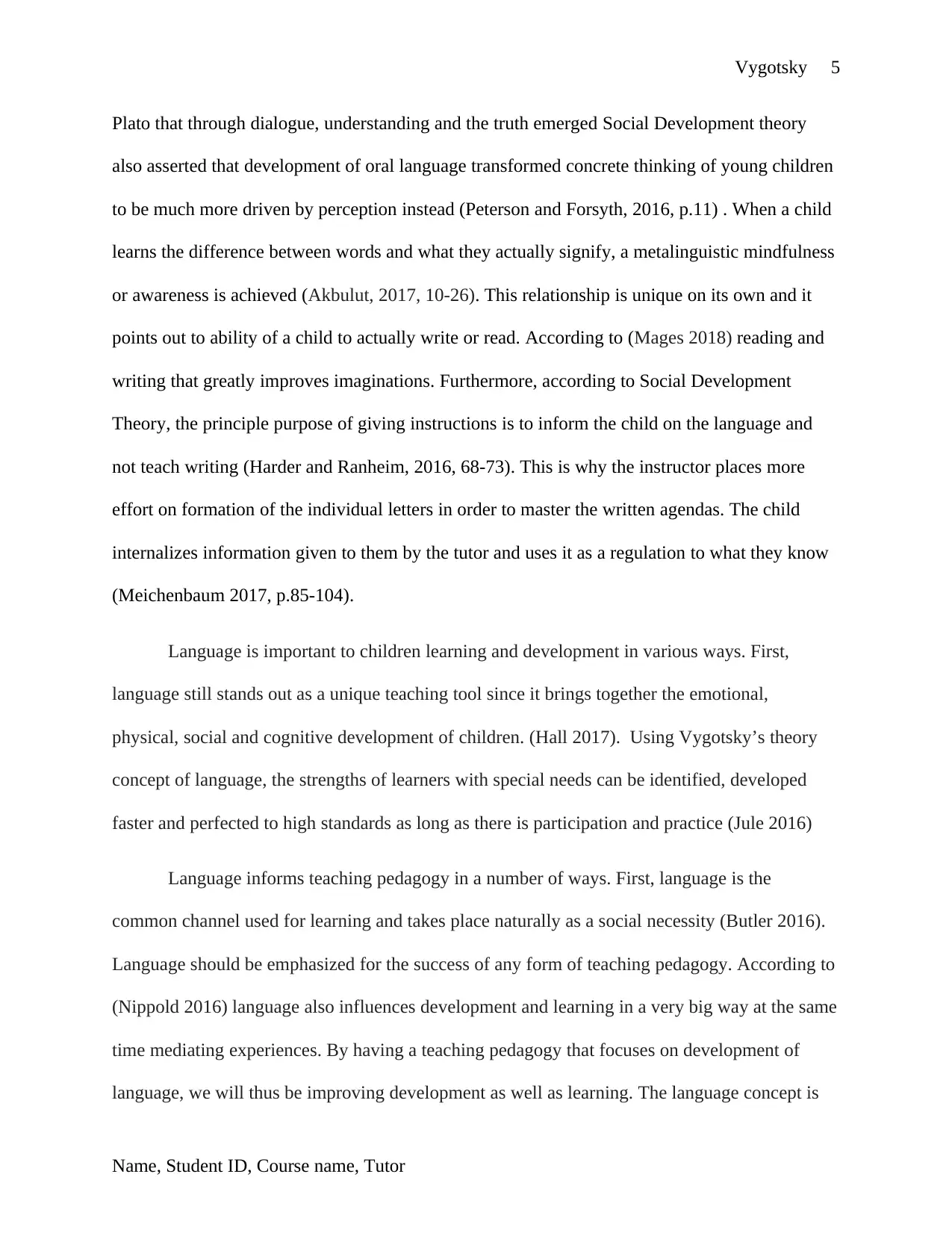
Vygotsky 5
Plato that through dialogue, understanding and the truth emerged Social Development theory
also asserted that development of oral language transformed concrete thinking of young children
to be much more driven by perception instead (Peterson and Forsyth, 2016, p.11) . When a child
learns the difference between words and what they actually signify, a metalinguistic mindfulness
or awareness is achieved (Akbulut, 2017, 10-26). This relationship is unique on its own and it
points out to ability of a child to actually write or read. According to (Mages 2018) reading and
writing that greatly improves imaginations. Furthermore, according to Social Development
Theory, the principle purpose of giving instructions is to inform the child on the language and
not teach writing (Harder and Ranheim, 2016, 68-73). This is why the instructor places more
effort on formation of the individual letters in order to master the written agendas. The child
internalizes information given to them by the tutor and uses it as a regulation to what they know
(Meichenbaum 2017, p.85-104).
Language is important to children learning and development in various ways. First,
language still stands out as a unique teaching tool since it brings together the emotional,
physical, social and cognitive development of children. (Hall 2017). Using Vygotsky’s theory
concept of language, the strengths of learners with special needs can be identified, developed
faster and perfected to high standards as long as there is participation and practice (Jule 2016)
Language informs teaching pedagogy in a number of ways. First, language is the
common channel used for learning and takes place naturally as a social necessity (Butler 2016).
Language should be emphasized for the success of any form of teaching pedagogy. According to
(Nippold 2016) language also influences development and learning in a very big way at the same
time mediating experiences. By having a teaching pedagogy that focuses on development of
language, we will thus be improving development as well as learning. The language concept is
Name, Student ID, Course name, Tutor
Plato that through dialogue, understanding and the truth emerged Social Development theory
also asserted that development of oral language transformed concrete thinking of young children
to be much more driven by perception instead (Peterson and Forsyth, 2016, p.11) . When a child
learns the difference between words and what they actually signify, a metalinguistic mindfulness
or awareness is achieved (Akbulut, 2017, 10-26). This relationship is unique on its own and it
points out to ability of a child to actually write or read. According to (Mages 2018) reading and
writing that greatly improves imaginations. Furthermore, according to Social Development
Theory, the principle purpose of giving instructions is to inform the child on the language and
not teach writing (Harder and Ranheim, 2016, 68-73). This is why the instructor places more
effort on formation of the individual letters in order to master the written agendas. The child
internalizes information given to them by the tutor and uses it as a regulation to what they know
(Meichenbaum 2017, p.85-104).
Language is important to children learning and development in various ways. First,
language still stands out as a unique teaching tool since it brings together the emotional,
physical, social and cognitive development of children. (Hall 2017). Using Vygotsky’s theory
concept of language, the strengths of learners with special needs can be identified, developed
faster and perfected to high standards as long as there is participation and practice (Jule 2016)
Language informs teaching pedagogy in a number of ways. First, language is the
common channel used for learning and takes place naturally as a social necessity (Butler 2016).
Language should be emphasized for the success of any form of teaching pedagogy. According to
(Nippold 2016) language also influences development and learning in a very big way at the same
time mediating experiences. By having a teaching pedagogy that focuses on development of
language, we will thus be improving development as well as learning. The language concept is
Name, Student ID, Course name, Tutor
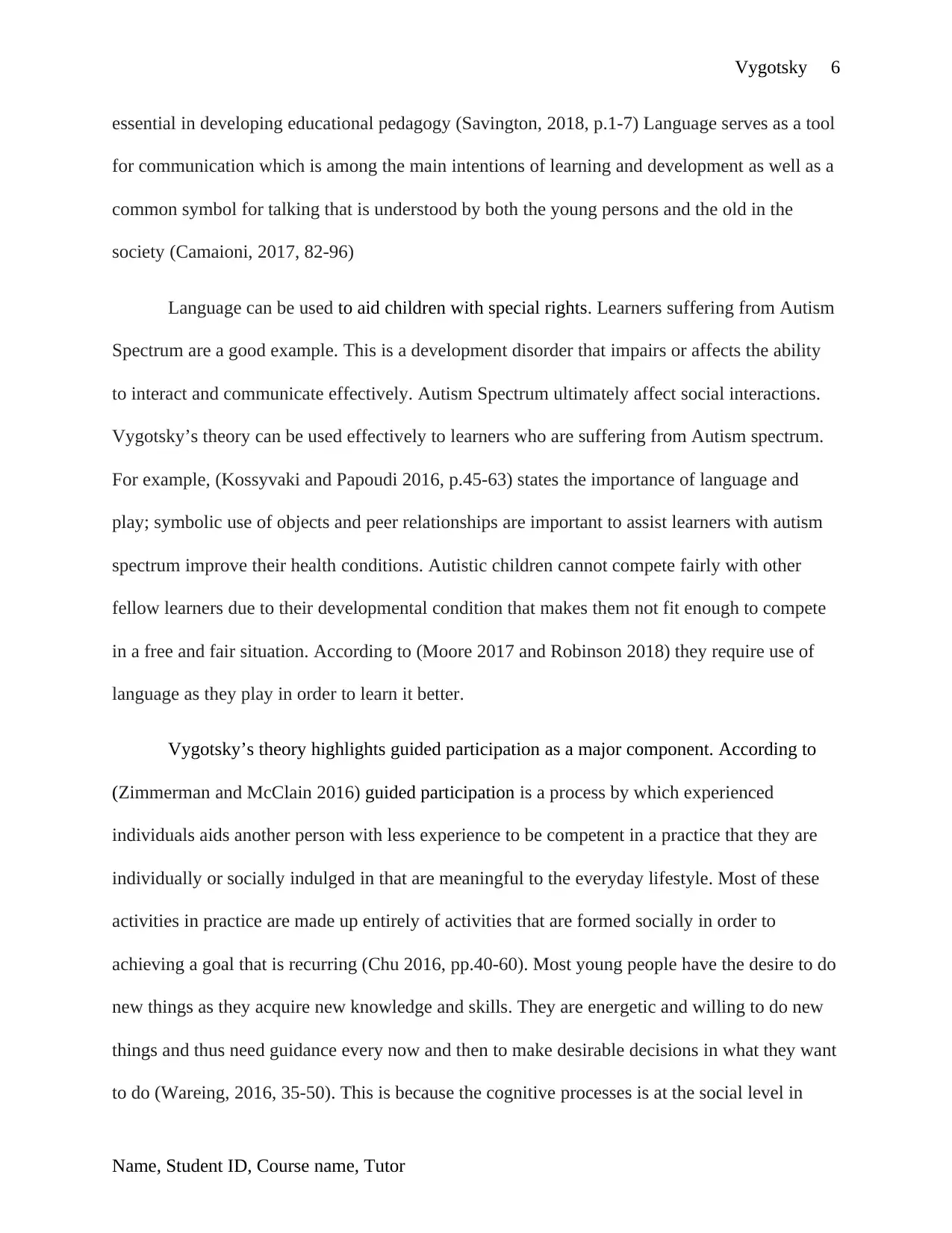
Vygotsky 6
essential in developing educational pedagogy (Savington, 2018, p.1-7) Language serves as a tool
for communication which is among the main intentions of learning and development as well as a
common symbol for talking that is understood by both the young persons and the old in the
society (Camaioni, 2017, 82-96)
Language can be used to aid children with special rights. Learners suffering from Autism
Spectrum are a good example. This is a development disorder that impairs or affects the ability
to interact and communicate effectively. Autism Spectrum ultimately affect social interactions.
Vygotsky’s theory can be used effectively to learners who are suffering from Autism spectrum.
For example, (Kossyvaki and Papoudi 2016, p.45-63) states the importance of language and
play; symbolic use of objects and peer relationships are important to assist learners with autism
spectrum improve their health conditions. Autistic children cannot compete fairly with other
fellow learners due to their developmental condition that makes them not fit enough to compete
in a free and fair situation. According to (Moore 2017 and Robinson 2018) they require use of
language as they play in order to learn it better.
Vygotsky’s theory highlights guided participation as a major component. According to
(Zimmerman and McClain 2016) guided participation is a process by which experienced
individuals aids another person with less experience to be competent in a practice that they are
individually or socially indulged in that are meaningful to the everyday lifestyle. Most of these
activities in practice are made up entirely of activities that are formed socially in order to
achieving a goal that is recurring (Chu 2016, pp.40-60). Most young people have the desire to do
new things as they acquire new knowledge and skills. They are energetic and willing to do new
things and thus need guidance every now and then to make desirable decisions in what they want
to do (Wareing, 2016, 35-50). This is because the cognitive processes is at the social level in
Name, Student ID, Course name, Tutor
essential in developing educational pedagogy (Savington, 2018, p.1-7) Language serves as a tool
for communication which is among the main intentions of learning and development as well as a
common symbol for talking that is understood by both the young persons and the old in the
society (Camaioni, 2017, 82-96)
Language can be used to aid children with special rights. Learners suffering from Autism
Spectrum are a good example. This is a development disorder that impairs or affects the ability
to interact and communicate effectively. Autism Spectrum ultimately affect social interactions.
Vygotsky’s theory can be used effectively to learners who are suffering from Autism spectrum.
For example, (Kossyvaki and Papoudi 2016, p.45-63) states the importance of language and
play; symbolic use of objects and peer relationships are important to assist learners with autism
spectrum improve their health conditions. Autistic children cannot compete fairly with other
fellow learners due to their developmental condition that makes them not fit enough to compete
in a free and fair situation. According to (Moore 2017 and Robinson 2018) they require use of
language as they play in order to learn it better.
Vygotsky’s theory highlights guided participation as a major component. According to
(Zimmerman and McClain 2016) guided participation is a process by which experienced
individuals aids another person with less experience to be competent in a practice that they are
individually or socially indulged in that are meaningful to the everyday lifestyle. Most of these
activities in practice are made up entirely of activities that are formed socially in order to
achieving a goal that is recurring (Chu 2016, pp.40-60). Most young people have the desire to do
new things as they acquire new knowledge and skills. They are energetic and willing to do new
things and thus need guidance every now and then to make desirable decisions in what they want
to do (Wareing, 2016, 35-50). This is because the cognitive processes is at the social level in
Name, Student ID, Course name, Tutor
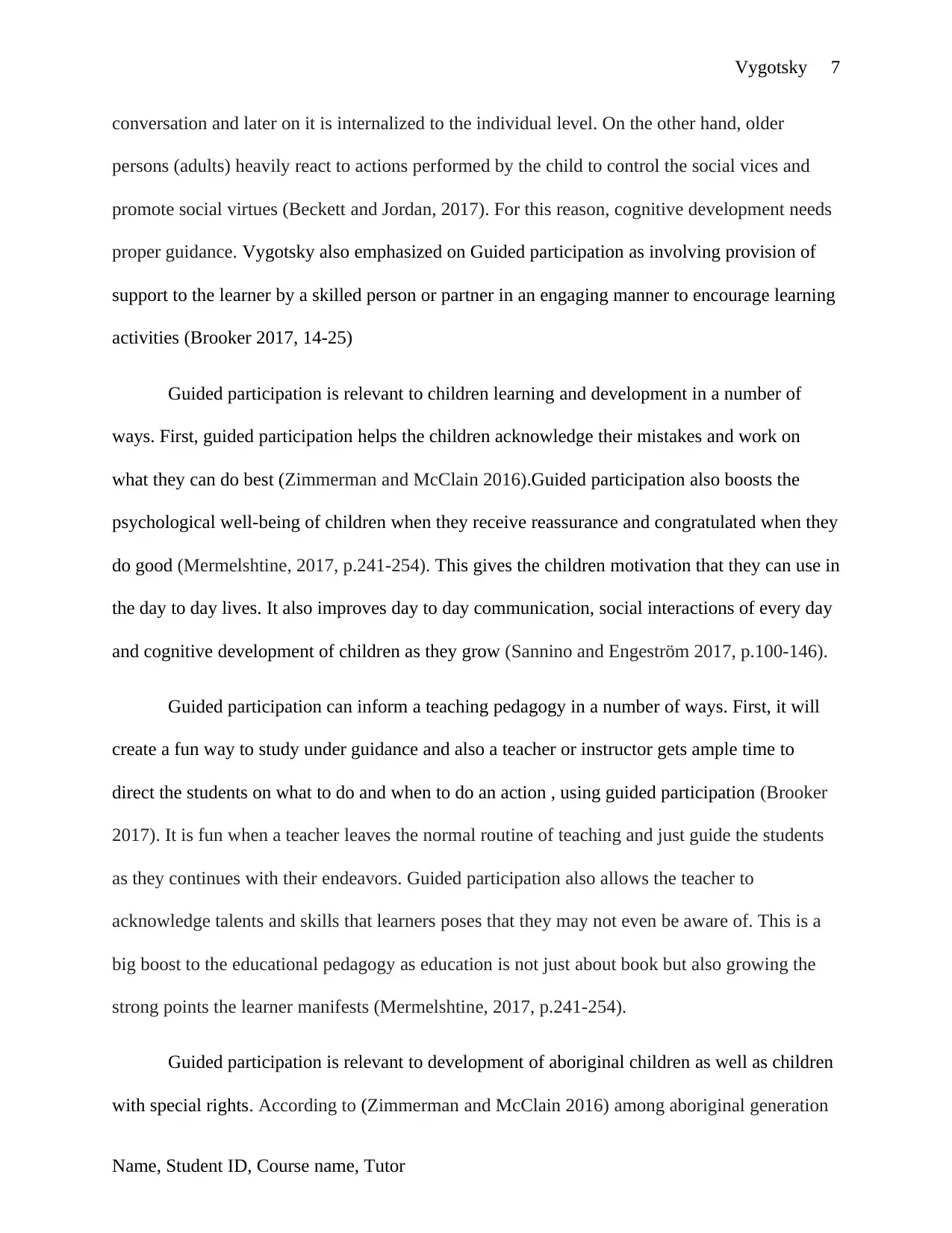
Vygotsky 7
conversation and later on it is internalized to the individual level. On the other hand, older
persons (adults) heavily react to actions performed by the child to control the social vices and
promote social virtues (Beckett and Jordan, 2017). For this reason, cognitive development needs
proper guidance. Vygotsky also emphasized on Guided participation as involving provision of
support to the learner by a skilled person or partner in an engaging manner to encourage learning
activities (Brooker 2017, 14-25)
Guided participation is relevant to children learning and development in a number of
ways. First, guided participation helps the children acknowledge their mistakes and work on
what they can do best (Zimmerman and McClain 2016).Guided participation also boosts the
psychological well-being of children when they receive reassurance and congratulated when they
do good (Mermelshtine, 2017, p.241-254). This gives the children motivation that they can use in
the day to day lives. It also improves day to day communication, social interactions of every day
and cognitive development of children as they grow (Sannino and Engeström 2017, p.100-146).
Guided participation can inform a teaching pedagogy in a number of ways. First, it will
create a fun way to study under guidance and also a teacher or instructor gets ample time to
direct the students on what to do and when to do an action , using guided participation (Brooker
2017). It is fun when a teacher leaves the normal routine of teaching and just guide the students
as they continues with their endeavors. Guided participation also allows the teacher to
acknowledge talents and skills that learners poses that they may not even be aware of. This is a
big boost to the educational pedagogy as education is not just about book but also growing the
strong points the learner manifests (Mermelshtine, 2017, p.241-254).
Guided participation is relevant to development of aboriginal children as well as children
with special rights. According to (Zimmerman and McClain 2016) among aboriginal generation
Name, Student ID, Course name, Tutor
conversation and later on it is internalized to the individual level. On the other hand, older
persons (adults) heavily react to actions performed by the child to control the social vices and
promote social virtues (Beckett and Jordan, 2017). For this reason, cognitive development needs
proper guidance. Vygotsky also emphasized on Guided participation as involving provision of
support to the learner by a skilled person or partner in an engaging manner to encourage learning
activities (Brooker 2017, 14-25)
Guided participation is relevant to children learning and development in a number of
ways. First, guided participation helps the children acknowledge their mistakes and work on
what they can do best (Zimmerman and McClain 2016).Guided participation also boosts the
psychological well-being of children when they receive reassurance and congratulated when they
do good (Mermelshtine, 2017, p.241-254). This gives the children motivation that they can use in
the day to day lives. It also improves day to day communication, social interactions of every day
and cognitive development of children as they grow (Sannino and Engeström 2017, p.100-146).
Guided participation can inform a teaching pedagogy in a number of ways. First, it will
create a fun way to study under guidance and also a teacher or instructor gets ample time to
direct the students on what to do and when to do an action , using guided participation (Brooker
2017). It is fun when a teacher leaves the normal routine of teaching and just guide the students
as they continues with their endeavors. Guided participation also allows the teacher to
acknowledge talents and skills that learners poses that they may not even be aware of. This is a
big boost to the educational pedagogy as education is not just about book but also growing the
strong points the learner manifests (Mermelshtine, 2017, p.241-254).
Guided participation is relevant to development of aboriginal children as well as children
with special rights. According to (Zimmerman and McClain 2016) among aboriginal generation
Name, Student ID, Course name, Tutor
Paraphrase This Document
Need a fresh take? Get an instant paraphrase of this document with our AI Paraphraser
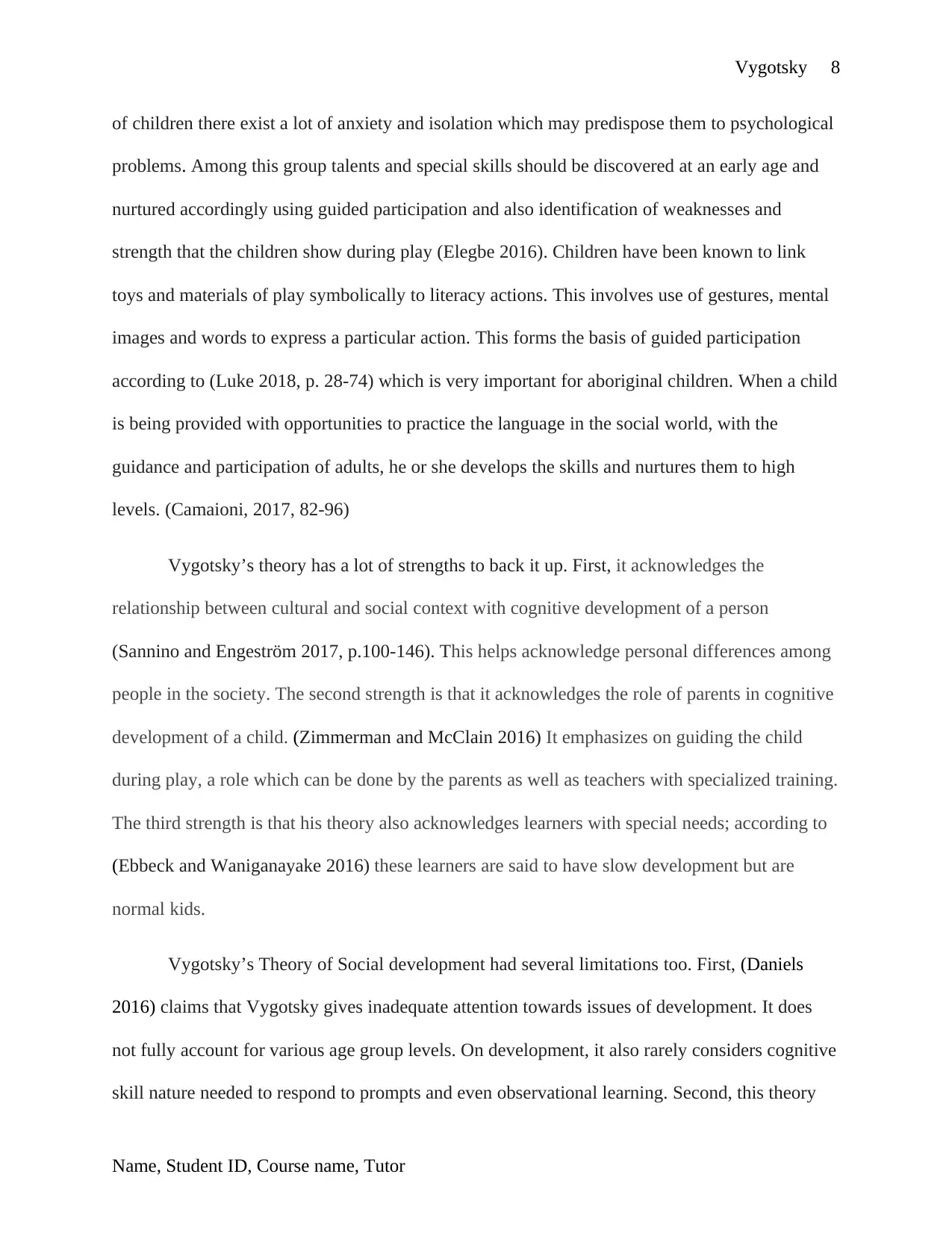
Vygotsky 8
of children there exist a lot of anxiety and isolation which may predispose them to psychological
problems. Among this group talents and special skills should be discovered at an early age and
nurtured accordingly using guided participation and also identification of weaknesses and
strength that the children show during play (Elegbe 2016). Children have been known to link
toys and materials of play symbolically to literacy actions. This involves use of gestures, mental
images and words to express a particular action. This forms the basis of guided participation
according to (Luke 2018, p. 28-74) which is very important for aboriginal children. When a child
is being provided with opportunities to practice the language in the social world, with the
guidance and participation of adults, he or she develops the skills and nurtures them to high
levels. (Camaioni, 2017, 82-96)
Vygotsky’s theory has a lot of strengths to back it up. First, it acknowledges the
relationship between cultural and social context with cognitive development of a person
(Sannino and Engeström 2017, p.100-146). This helps acknowledge personal differences among
people in the society. The second strength is that it acknowledges the role of parents in cognitive
development of a child. (Zimmerman and McClain 2016) It emphasizes on guiding the child
during play, a role which can be done by the parents as well as teachers with specialized training.
The third strength is that his theory also acknowledges learners with special needs; according to
(Ebbeck and Waniganayake 2016) these learners are said to have slow development but are
normal kids.
Vygotsky’s Theory of Social development had several limitations too. First, (Daniels
2016) claims that Vygotsky gives inadequate attention towards issues of development. It does
not fully account for various age group levels. On development, it also rarely considers cognitive
skill nature needed to respond to prompts and even observational learning. Second, this theory
Name, Student ID, Course name, Tutor
of children there exist a lot of anxiety and isolation which may predispose them to psychological
problems. Among this group talents and special skills should be discovered at an early age and
nurtured accordingly using guided participation and also identification of weaknesses and
strength that the children show during play (Elegbe 2016). Children have been known to link
toys and materials of play symbolically to literacy actions. This involves use of gestures, mental
images and words to express a particular action. This forms the basis of guided participation
according to (Luke 2018, p. 28-74) which is very important for aboriginal children. When a child
is being provided with opportunities to practice the language in the social world, with the
guidance and participation of adults, he or she develops the skills and nurtures them to high
levels. (Camaioni, 2017, 82-96)
Vygotsky’s theory has a lot of strengths to back it up. First, it acknowledges the
relationship between cultural and social context with cognitive development of a person
(Sannino and Engeström 2017, p.100-146). This helps acknowledge personal differences among
people in the society. The second strength is that it acknowledges the role of parents in cognitive
development of a child. (Zimmerman and McClain 2016) It emphasizes on guiding the child
during play, a role which can be done by the parents as well as teachers with specialized training.
The third strength is that his theory also acknowledges learners with special needs; according to
(Ebbeck and Waniganayake 2016) these learners are said to have slow development but are
normal kids.
Vygotsky’s Theory of Social development had several limitations too. First, (Daniels
2016) claims that Vygotsky gives inadequate attention towards issues of development. It does
not fully account for various age group levels. On development, it also rarely considers cognitive
skill nature needed to respond to prompts and even observational learning. Second, this theory
Name, Student ID, Course name, Tutor
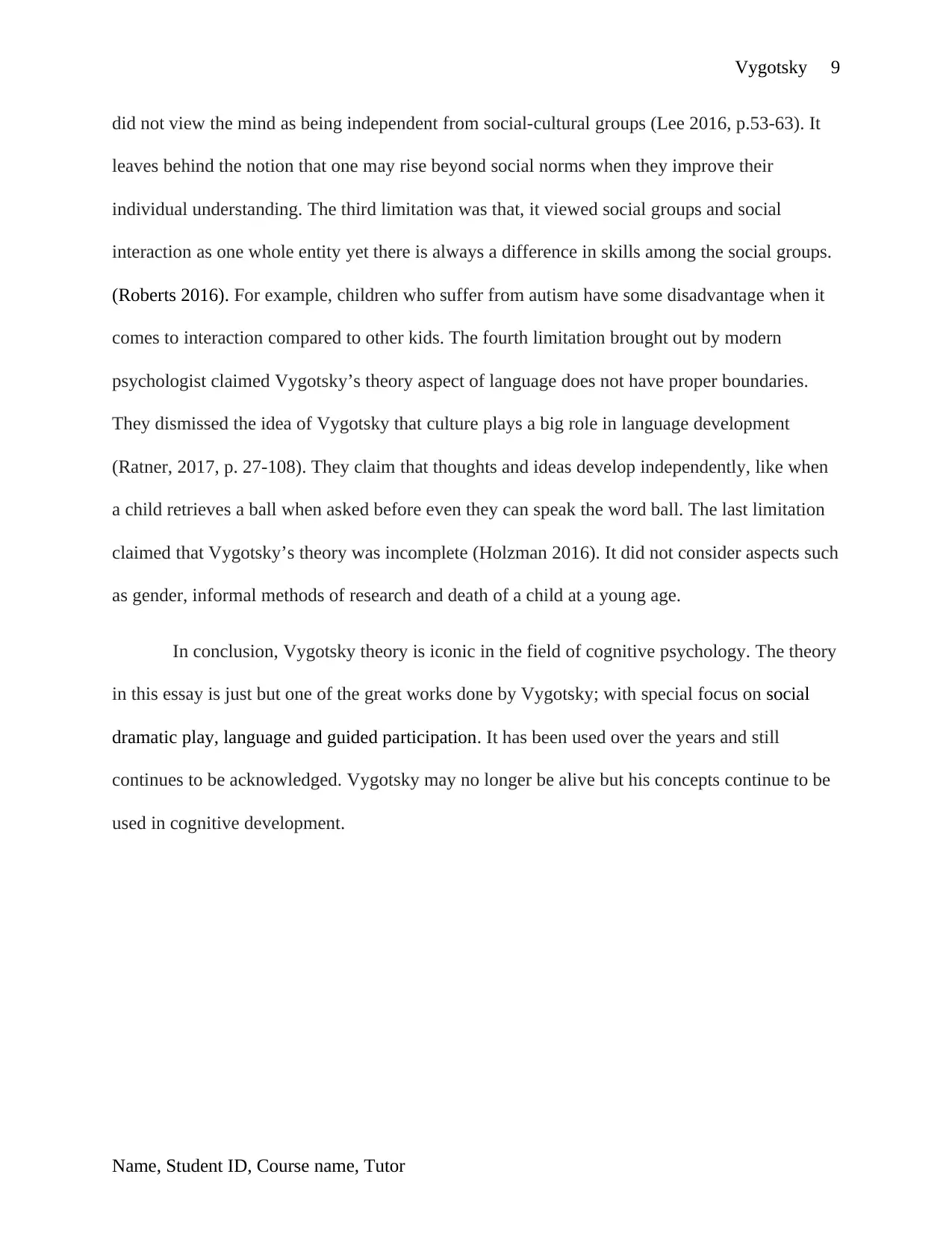
Vygotsky 9
did not view the mind as being independent from social-cultural groups (Lee 2016, p.53-63). It
leaves behind the notion that one may rise beyond social norms when they improve their
individual understanding. The third limitation was that, it viewed social groups and social
interaction as one whole entity yet there is always a difference in skills among the social groups.
(Roberts 2016). For example, children who suffer from autism have some disadvantage when it
comes to interaction compared to other kids. The fourth limitation brought out by modern
psychologist claimed Vygotsky’s theory aspect of language does not have proper boundaries.
They dismissed the idea of Vygotsky that culture plays a big role in language development
(Ratner, 2017, p. 27-108). They claim that thoughts and ideas develop independently, like when
a child retrieves a ball when asked before even they can speak the word ball. The last limitation
claimed that Vygotsky’s theory was incomplete (Holzman 2016). It did not consider aspects such
as gender, informal methods of research and death of a child at a young age.
In conclusion, Vygotsky theory is iconic in the field of cognitive psychology. The theory
in this essay is just but one of the great works done by Vygotsky; with special focus on social
dramatic play, language and guided participation. It has been used over the years and still
continues to be acknowledged. Vygotsky may no longer be alive but his concepts continue to be
used in cognitive development.
Name, Student ID, Course name, Tutor
did not view the mind as being independent from social-cultural groups (Lee 2016, p.53-63). It
leaves behind the notion that one may rise beyond social norms when they improve their
individual understanding. The third limitation was that, it viewed social groups and social
interaction as one whole entity yet there is always a difference in skills among the social groups.
(Roberts 2016). For example, children who suffer from autism have some disadvantage when it
comes to interaction compared to other kids. The fourth limitation brought out by modern
psychologist claimed Vygotsky’s theory aspect of language does not have proper boundaries.
They dismissed the idea of Vygotsky that culture plays a big role in language development
(Ratner, 2017, p. 27-108). They claim that thoughts and ideas develop independently, like when
a child retrieves a ball when asked before even they can speak the word ball. The last limitation
claimed that Vygotsky’s theory was incomplete (Holzman 2016). It did not consider aspects such
as gender, informal methods of research and death of a child at a young age.
In conclusion, Vygotsky theory is iconic in the field of cognitive psychology. The theory
in this essay is just but one of the great works done by Vygotsky; with special focus on social
dramatic play, language and guided participation. It has been used over the years and still
continues to be acknowledged. Vygotsky may no longer be alive but his concepts continue to be
used in cognitive development.
Name, Student ID, Course name, Tutor
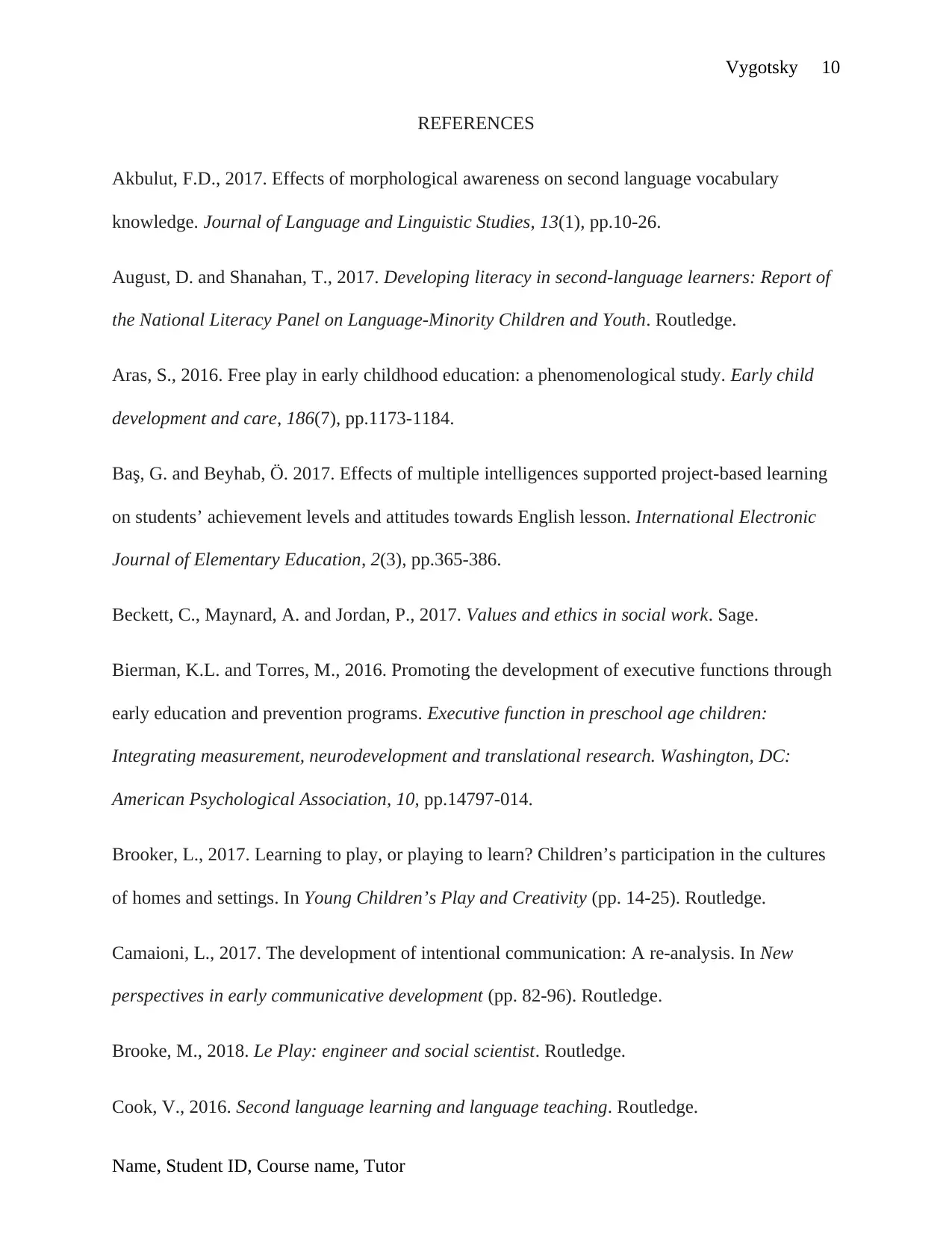
Vygotsky 10
REFERENCES
Akbulut, F.D., 2017. Effects of morphological awareness on second language vocabulary
knowledge. Journal of Language and Linguistic Studies, 13(1), pp.10-26.
August, D. and Shanahan, T., 2017. Developing literacy in second-language learners: Report of
the National Literacy Panel on Language-Minority Children and Youth. Routledge.
Aras, S., 2016. Free play in early childhood education: a phenomenological study. Early child
development and care, 186(7), pp.1173-1184.
Baş, G. and Beyhab, Ö. 2017. Effects of multiple intelligences supported project-based learning
on students’ achievement levels and attitudes towards English lesson. International Electronic
Journal of Elementary Education, 2(3), pp.365-386.
Beckett, C., Maynard, A. and Jordan, P., 2017. Values and ethics in social work. Sage.
Bierman, K.L. and Torres, M., 2016. Promoting the development of executive functions through
early education and prevention programs. Executive function in preschool age children:
Integrating measurement, neurodevelopment and translational research. Washington, DC:
American Psychological Association, 10, pp.14797-014.
Brooker, L., 2017. Learning to play, or playing to learn? Children’s participation in the cultures
of homes and settings. In Young Children’s Play and Creativity (pp. 14-25). Routledge.
Camaioni, L., 2017. The development of intentional communication: A re-analysis. In New
perspectives in early communicative development (pp. 82-96). Routledge.
Brooke, M., 2018. Le Play: engineer and social scientist. Routledge.
Cook, V., 2016. Second language learning and language teaching. Routledge.
Name, Student ID, Course name, Tutor
REFERENCES
Akbulut, F.D., 2017. Effects of morphological awareness on second language vocabulary
knowledge. Journal of Language and Linguistic Studies, 13(1), pp.10-26.
August, D. and Shanahan, T., 2017. Developing literacy in second-language learners: Report of
the National Literacy Panel on Language-Minority Children and Youth. Routledge.
Aras, S., 2016. Free play in early childhood education: a phenomenological study. Early child
development and care, 186(7), pp.1173-1184.
Baş, G. and Beyhab, Ö. 2017. Effects of multiple intelligences supported project-based learning
on students’ achievement levels and attitudes towards English lesson. International Electronic
Journal of Elementary Education, 2(3), pp.365-386.
Beckett, C., Maynard, A. and Jordan, P., 2017. Values and ethics in social work. Sage.
Bierman, K.L. and Torres, M., 2016. Promoting the development of executive functions through
early education and prevention programs. Executive function in preschool age children:
Integrating measurement, neurodevelopment and translational research. Washington, DC:
American Psychological Association, 10, pp.14797-014.
Brooker, L., 2017. Learning to play, or playing to learn? Children’s participation in the cultures
of homes and settings. In Young Children’s Play and Creativity (pp. 14-25). Routledge.
Camaioni, L., 2017. The development of intentional communication: A re-analysis. In New
perspectives in early communicative development (pp. 82-96). Routledge.
Brooke, M., 2018. Le Play: engineer and social scientist. Routledge.
Cook, V., 2016. Second language learning and language teaching. Routledge.
Name, Student ID, Course name, Tutor
Secure Best Marks with AI Grader
Need help grading? Try our AI Grader for instant feedback on your assignments.
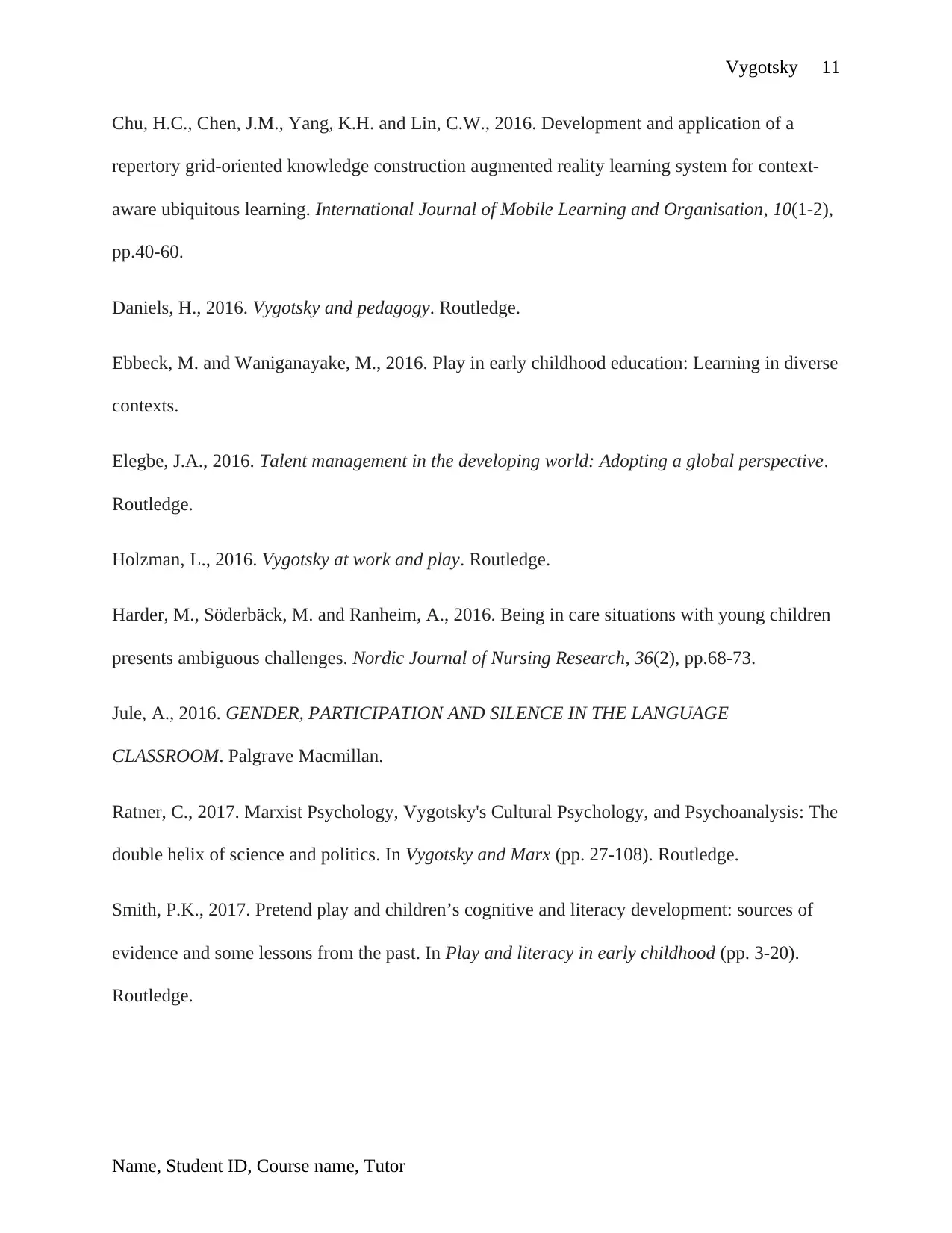
Vygotsky 11
Chu, H.C., Chen, J.M., Yang, K.H. and Lin, C.W., 2016. Development and application of a
repertory grid-oriented knowledge construction augmented reality learning system for context-
aware ubiquitous learning. International Journal of Mobile Learning and Organisation, 10(1-2),
pp.40-60.
Daniels, H., 2016. Vygotsky and pedagogy. Routledge.
Ebbeck, M. and Waniganayake, M., 2016. Play in early childhood education: Learning in diverse
contexts.
Elegbe, J.A., 2016. Talent management in the developing world: Adopting a global perspective.
Routledge.
Holzman, L., 2016. Vygotsky at work and play. Routledge.
Harder, M., Söderbäck, M. and Ranheim, A., 2016. Being in care situations with young children
presents ambiguous challenges. Nordic Journal of Nursing Research, 36(2), pp.68-73.
Jule, A., 2016. GENDER, PARTICIPATION AND SILENCE IN THE LANGUAGE
CLASSROOM. Palgrave Macmillan.
Ratner, C., 2017. Marxist Psychology, Vygotsky's Cultural Psychology, and Psychoanalysis: The
double helix of science and politics. In Vygotsky and Marx (pp. 27-108). Routledge.
Smith, P.K., 2017. Pretend play and children’s cognitive and literacy development: sources of
evidence and some lessons from the past. In Play and literacy in early childhood (pp. 3-20).
Routledge.
Name, Student ID, Course name, Tutor
Chu, H.C., Chen, J.M., Yang, K.H. and Lin, C.W., 2016. Development and application of a
repertory grid-oriented knowledge construction augmented reality learning system for context-
aware ubiquitous learning. International Journal of Mobile Learning and Organisation, 10(1-2),
pp.40-60.
Daniels, H., 2016. Vygotsky and pedagogy. Routledge.
Ebbeck, M. and Waniganayake, M., 2016. Play in early childhood education: Learning in diverse
contexts.
Elegbe, J.A., 2016. Talent management in the developing world: Adopting a global perspective.
Routledge.
Holzman, L., 2016. Vygotsky at work and play. Routledge.
Harder, M., Söderbäck, M. and Ranheim, A., 2016. Being in care situations with young children
presents ambiguous challenges. Nordic Journal of Nursing Research, 36(2), pp.68-73.
Jule, A., 2016. GENDER, PARTICIPATION AND SILENCE IN THE LANGUAGE
CLASSROOM. Palgrave Macmillan.
Ratner, C., 2017. Marxist Psychology, Vygotsky's Cultural Psychology, and Psychoanalysis: The
double helix of science and politics. In Vygotsky and Marx (pp. 27-108). Routledge.
Smith, P.K., 2017. Pretend play and children’s cognitive and literacy development: sources of
evidence and some lessons from the past. In Play and literacy in early childhood (pp. 3-20).
Routledge.
Name, Student ID, Course name, Tutor
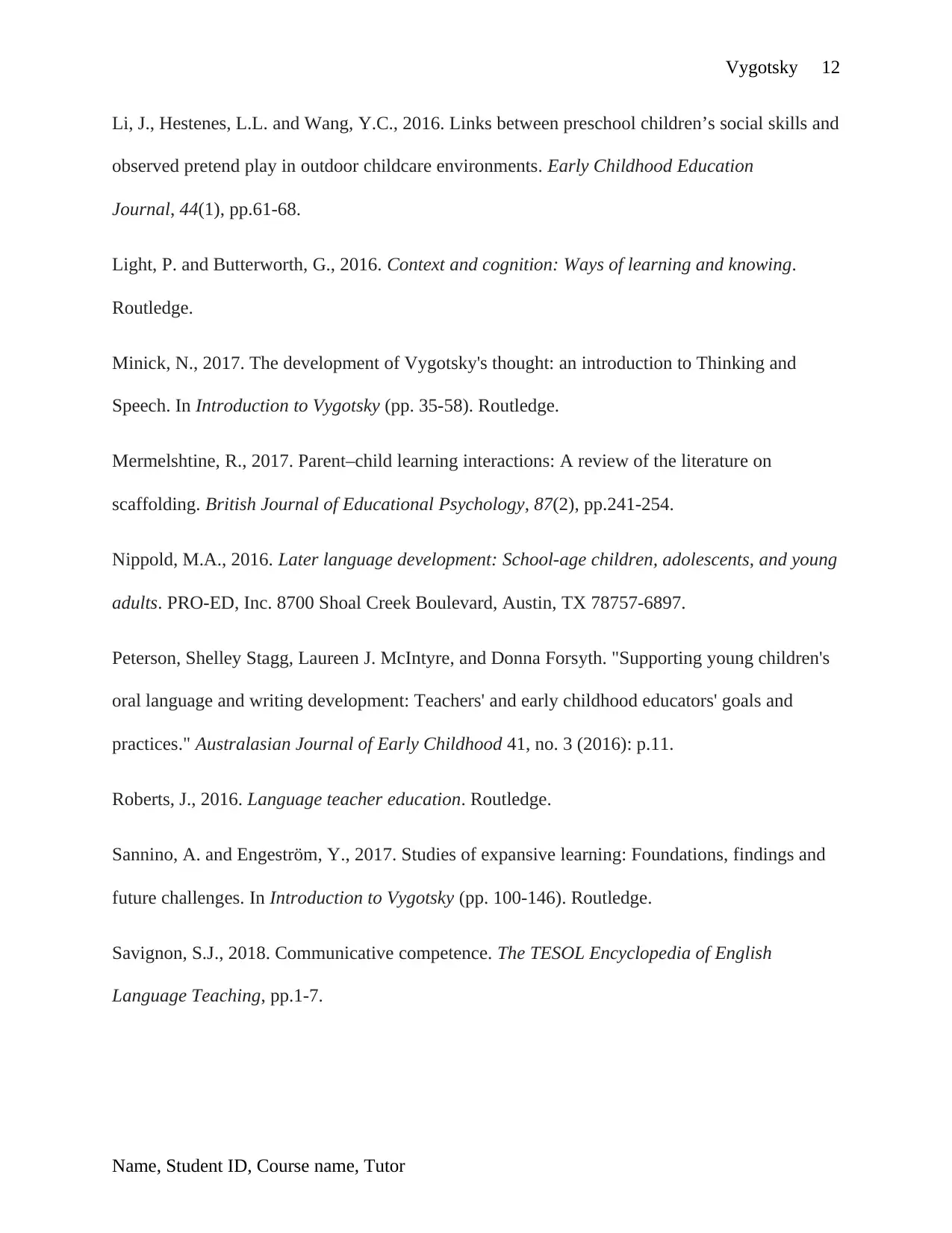
Vygotsky 12
Li, J., Hestenes, L.L. and Wang, Y.C., 2016. Links between preschool children’s social skills and
observed pretend play in outdoor childcare environments. Early Childhood Education
Journal, 44(1), pp.61-68.
Light, P. and Butterworth, G., 2016. Context and cognition: Ways of learning and knowing.
Routledge.
Minick, N., 2017. The development of Vygotsky's thought: an introduction to Thinking and
Speech. In Introduction to Vygotsky (pp. 35-58). Routledge.
Mermelshtine, R., 2017. Parent–child learning interactions: A review of the literature on
scaffolding. British Journal of Educational Psychology, 87(2), pp.241-254.
Nippold, M.A., 2016. Later language development: School-age children, adolescents, and young
adults. PRO-ED, Inc. 8700 Shoal Creek Boulevard, Austin, TX 78757-6897.
Peterson, Shelley Stagg, Laureen J. McIntyre, and Donna Forsyth. "Supporting young children's
oral language and writing development: Teachers' and early childhood educators' goals and
practices." Australasian Journal of Early Childhood 41, no. 3 (2016): p.11.
Roberts, J., 2016. Language teacher education. Routledge.
Sannino, A. and Engeström, Y., 2017. Studies of expansive learning: Foundations, findings and
future challenges. In Introduction to Vygotsky (pp. 100-146). Routledge.
Savignon, S.J., 2018. Communicative competence. The TESOL Encyclopedia of English
Language Teaching, pp.1-7.
Name, Student ID, Course name, Tutor
Li, J., Hestenes, L.L. and Wang, Y.C., 2016. Links between preschool children’s social skills and
observed pretend play in outdoor childcare environments. Early Childhood Education
Journal, 44(1), pp.61-68.
Light, P. and Butterworth, G., 2016. Context and cognition: Ways of learning and knowing.
Routledge.
Minick, N., 2017. The development of Vygotsky's thought: an introduction to Thinking and
Speech. In Introduction to Vygotsky (pp. 35-58). Routledge.
Mermelshtine, R., 2017. Parent–child learning interactions: A review of the literature on
scaffolding. British Journal of Educational Psychology, 87(2), pp.241-254.
Nippold, M.A., 2016. Later language development: School-age children, adolescents, and young
adults. PRO-ED, Inc. 8700 Shoal Creek Boulevard, Austin, TX 78757-6897.
Peterson, Shelley Stagg, Laureen J. McIntyre, and Donna Forsyth. "Supporting young children's
oral language and writing development: Teachers' and early childhood educators' goals and
practices." Australasian Journal of Early Childhood 41, no. 3 (2016): p.11.
Roberts, J., 2016. Language teacher education. Routledge.
Sannino, A. and Engeström, Y., 2017. Studies of expansive learning: Foundations, findings and
future challenges. In Introduction to Vygotsky (pp. 100-146). Routledge.
Savignon, S.J., 2018. Communicative competence. The TESOL Encyclopedia of English
Language Teaching, pp.1-7.
Name, Student ID, Course name, Tutor
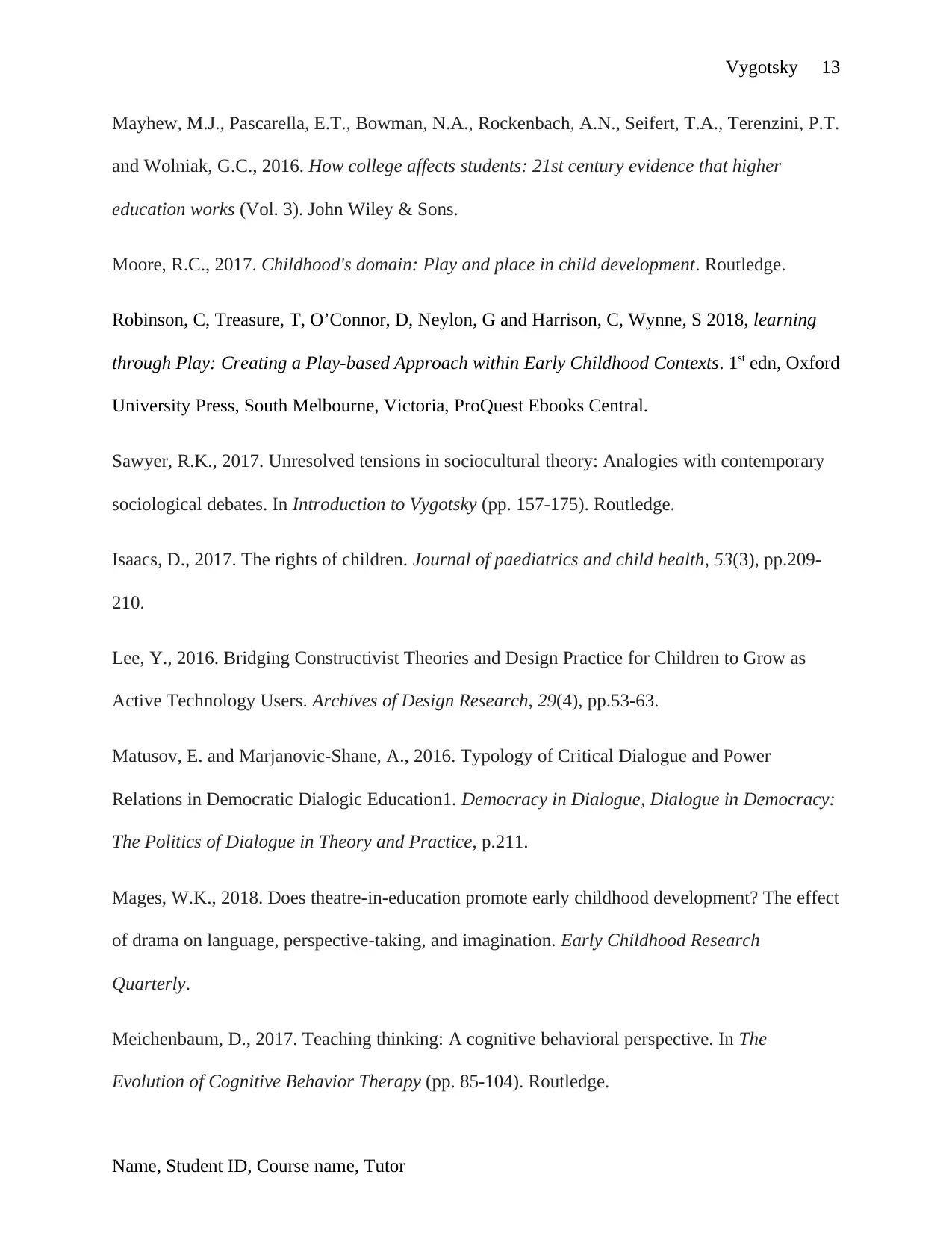
Vygotsky 13
Mayhew, M.J., Pascarella, E.T., Bowman, N.A., Rockenbach, A.N., Seifert, T.A., Terenzini, P.T.
and Wolniak, G.C., 2016. How college affects students: 21st century evidence that higher
education works (Vol. 3). John Wiley & Sons.
Moore, R.C., 2017. Childhood's domain: Play and place in child development. Routledge.
Robinson, C, Treasure, T, O’Connor, D, Neylon, G and Harrison, C, Wynne, S 2018, learning
through Play: Creating a Play-based Approach within Early Childhood Contexts. 1st edn, Oxford
University Press, South Melbourne, Victoria, ProQuest Ebooks Central.
Sawyer, R.K., 2017. Unresolved tensions in sociocultural theory: Analogies with contemporary
sociological debates. In Introduction to Vygotsky (pp. 157-175). Routledge.
Isaacs, D., 2017. The rights of children. Journal of paediatrics and child health, 53(3), pp.209-
210.
Lee, Y., 2016. Bridging Constructivist Theories and Design Practice for Children to Grow as
Active Technology Users. Archives of Design Research, 29(4), pp.53-63.
Matusov, E. and Marjanovic-Shane, A., 2016. Typology of Critical Dialogue and Power
Relations in Democratic Dialogic Education1. Democracy in Dialogue, Dialogue in Democracy:
The Politics of Dialogue in Theory and Practice, p.211.
Mages, W.K., 2018. Does theatre-in-education promote early childhood development? The effect
of drama on language, perspective-taking, and imagination. Early Childhood Research
Quarterly.
Meichenbaum, D., 2017. Teaching thinking: A cognitive behavioral perspective. In The
Evolution of Cognitive Behavior Therapy (pp. 85-104). Routledge.
Name, Student ID, Course name, Tutor
Mayhew, M.J., Pascarella, E.T., Bowman, N.A., Rockenbach, A.N., Seifert, T.A., Terenzini, P.T.
and Wolniak, G.C., 2016. How college affects students: 21st century evidence that higher
education works (Vol. 3). John Wiley & Sons.
Moore, R.C., 2017. Childhood's domain: Play and place in child development. Routledge.
Robinson, C, Treasure, T, O’Connor, D, Neylon, G and Harrison, C, Wynne, S 2018, learning
through Play: Creating a Play-based Approach within Early Childhood Contexts. 1st edn, Oxford
University Press, South Melbourne, Victoria, ProQuest Ebooks Central.
Sawyer, R.K., 2017. Unresolved tensions in sociocultural theory: Analogies with contemporary
sociological debates. In Introduction to Vygotsky (pp. 157-175). Routledge.
Isaacs, D., 2017. The rights of children. Journal of paediatrics and child health, 53(3), pp.209-
210.
Lee, Y., 2016. Bridging Constructivist Theories and Design Practice for Children to Grow as
Active Technology Users. Archives of Design Research, 29(4), pp.53-63.
Matusov, E. and Marjanovic-Shane, A., 2016. Typology of Critical Dialogue and Power
Relations in Democratic Dialogic Education1. Democracy in Dialogue, Dialogue in Democracy:
The Politics of Dialogue in Theory and Practice, p.211.
Mages, W.K., 2018. Does theatre-in-education promote early childhood development? The effect
of drama on language, perspective-taking, and imagination. Early Childhood Research
Quarterly.
Meichenbaum, D., 2017. Teaching thinking: A cognitive behavioral perspective. In The
Evolution of Cognitive Behavior Therapy (pp. 85-104). Routledge.
Name, Student ID, Course name, Tutor
Paraphrase This Document
Need a fresh take? Get an instant paraphrase of this document with our AI Paraphraser
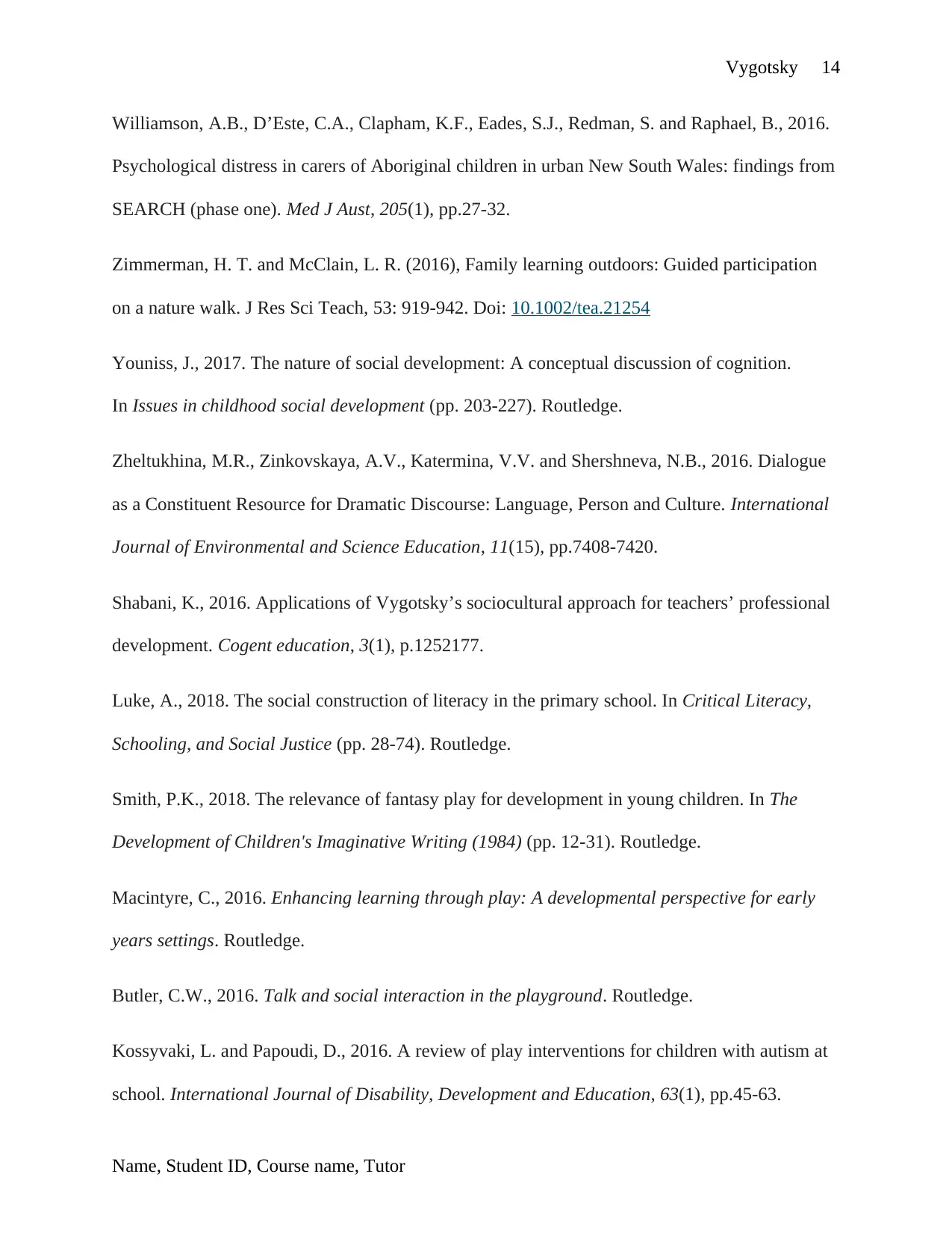
Vygotsky 14
Williamson, A.B., D’Este, C.A., Clapham, K.F., Eades, S.J., Redman, S. and Raphael, B., 2016.
Psychological distress in carers of Aboriginal children in urban New South Wales: findings from
SEARCH (phase one). Med J Aust, 205(1), pp.27-32.
Zimmerman, H. T. and McClain, L. R. (2016), Family learning outdoors: Guided participation
on a nature walk. J Res Sci Teach, 53: 919-942. Doi: 10.1002/tea.21254
Youniss, J., 2017. The nature of social development: A conceptual discussion of cognition.
In Issues in childhood social development (pp. 203-227). Routledge.
Zheltukhina, M.R., Zinkovskaya, A.V., Katermina, V.V. and Shershneva, N.B., 2016. Dialogue
as a Constituent Resource for Dramatic Discourse: Language, Person and Culture. International
Journal of Environmental and Science Education, 11(15), pp.7408-7420.
Shabani, K., 2016. Applications of Vygotsky’s sociocultural approach for teachers’ professional
development. Cogent education, 3(1), p.1252177.
Luke, A., 2018. The social construction of literacy in the primary school. In Critical Literacy,
Schooling, and Social Justice (pp. 28-74). Routledge.
Smith, P.K., 2018. The relevance of fantasy play for development in young children. In The
Development of Children's Imaginative Writing (1984) (pp. 12-31). Routledge.
Macintyre, C., 2016. Enhancing learning through play: A developmental perspective for early
years settings. Routledge.
Butler, C.W., 2016. Talk and social interaction in the playground. Routledge.
Kossyvaki, L. and Papoudi, D., 2016. A review of play interventions for children with autism at
school. International Journal of Disability, Development and Education, 63(1), pp.45-63.
Name, Student ID, Course name, Tutor
Williamson, A.B., D’Este, C.A., Clapham, K.F., Eades, S.J., Redman, S. and Raphael, B., 2016.
Psychological distress in carers of Aboriginal children in urban New South Wales: findings from
SEARCH (phase one). Med J Aust, 205(1), pp.27-32.
Zimmerman, H. T. and McClain, L. R. (2016), Family learning outdoors: Guided participation
on a nature walk. J Res Sci Teach, 53: 919-942. Doi: 10.1002/tea.21254
Youniss, J., 2017. The nature of social development: A conceptual discussion of cognition.
In Issues in childhood social development (pp. 203-227). Routledge.
Zheltukhina, M.R., Zinkovskaya, A.V., Katermina, V.V. and Shershneva, N.B., 2016. Dialogue
as a Constituent Resource for Dramatic Discourse: Language, Person and Culture. International
Journal of Environmental and Science Education, 11(15), pp.7408-7420.
Shabani, K., 2016. Applications of Vygotsky’s sociocultural approach for teachers’ professional
development. Cogent education, 3(1), p.1252177.
Luke, A., 2018. The social construction of literacy in the primary school. In Critical Literacy,
Schooling, and Social Justice (pp. 28-74). Routledge.
Smith, P.K., 2018. The relevance of fantasy play for development in young children. In The
Development of Children's Imaginative Writing (1984) (pp. 12-31). Routledge.
Macintyre, C., 2016. Enhancing learning through play: A developmental perspective for early
years settings. Routledge.
Butler, C.W., 2016. Talk and social interaction in the playground. Routledge.
Kossyvaki, L. and Papoudi, D., 2016. A review of play interventions for children with autism at
school. International Journal of Disability, Development and Education, 63(1), pp.45-63.
Name, Student ID, Course name, Tutor
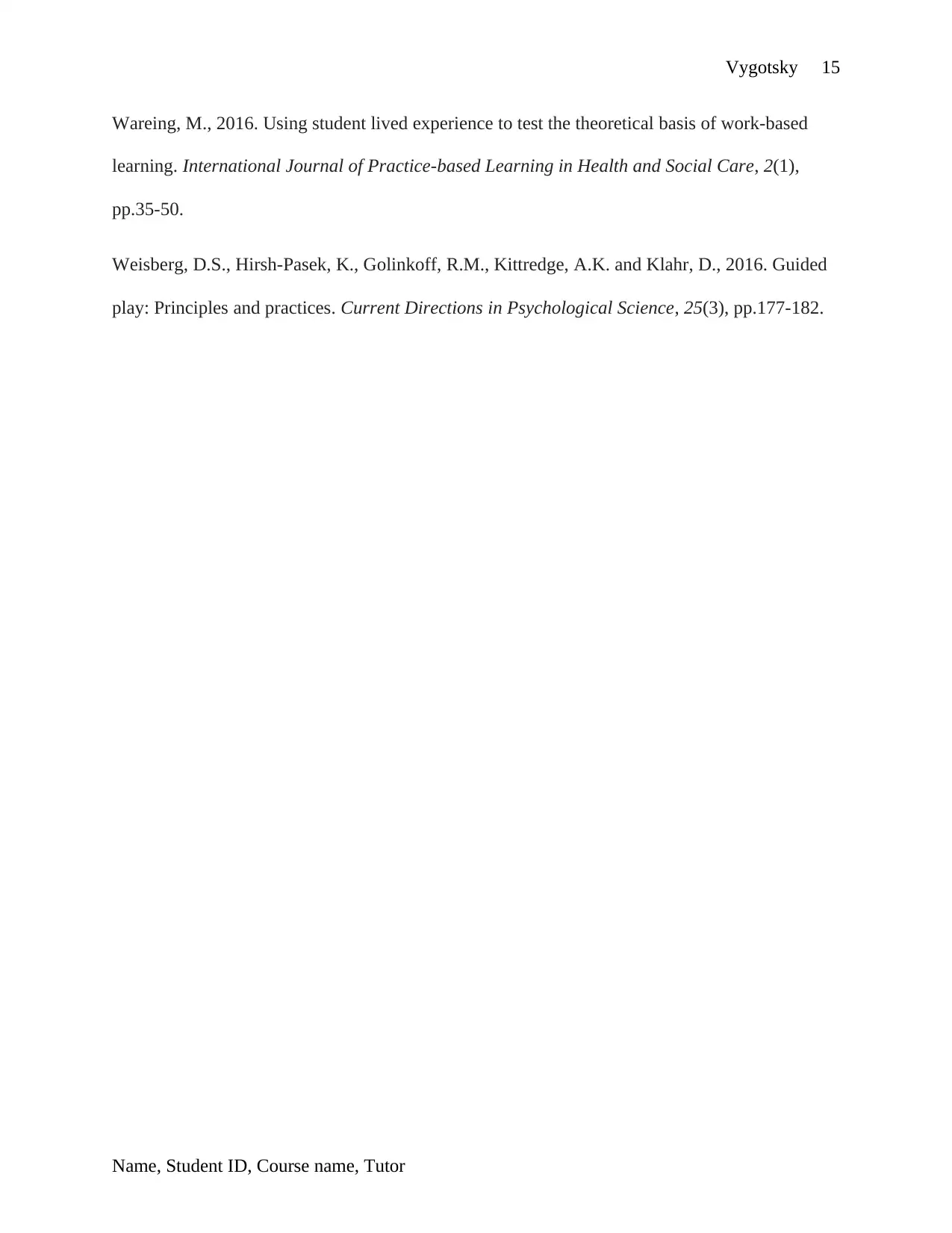
Vygotsky 15
Wareing, M., 2016. Using student lived experience to test the theoretical basis of work-based
learning. International Journal of Practice-based Learning in Health and Social Care, 2(1),
pp.35-50.
Weisberg, D.S., Hirsh-Pasek, K., Golinkoff, R.M., Kittredge, A.K. and Klahr, D., 2016. Guided
play: Principles and practices. Current Directions in Psychological Science, 25(3), pp.177-182.
Name, Student ID, Course name, Tutor
Wareing, M., 2016. Using student lived experience to test the theoretical basis of work-based
learning. International Journal of Practice-based Learning in Health and Social Care, 2(1),
pp.35-50.
Weisberg, D.S., Hirsh-Pasek, K., Golinkoff, R.M., Kittredge, A.K. and Klahr, D., 2016. Guided
play: Principles and practices. Current Directions in Psychological Science, 25(3), pp.177-182.
Name, Student ID, Course name, Tutor
1 out of 15
Related Documents
Your All-in-One AI-Powered Toolkit for Academic Success.
+13062052269
info@desklib.com
Available 24*7 on WhatsApp / Email
![[object Object]](/_next/static/media/star-bottom.7253800d.svg)
Unlock your academic potential
© 2024 | Zucol Services PVT LTD | All rights reserved.





